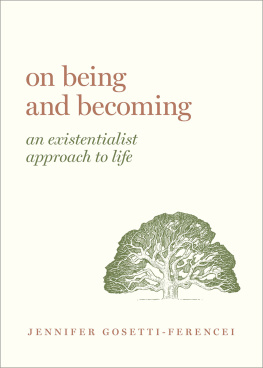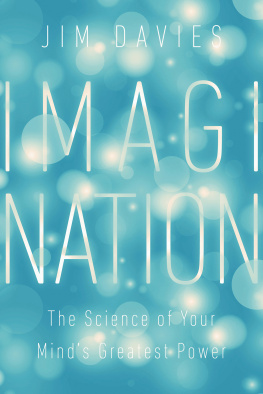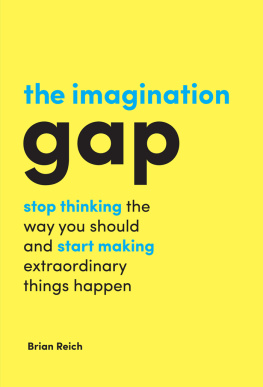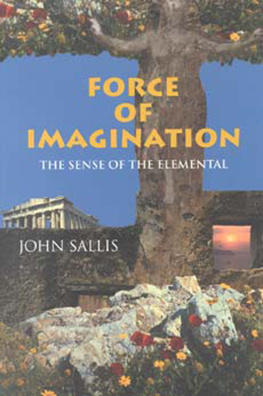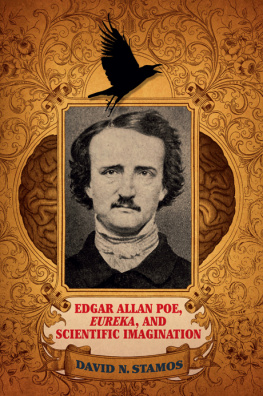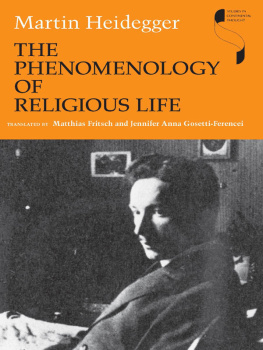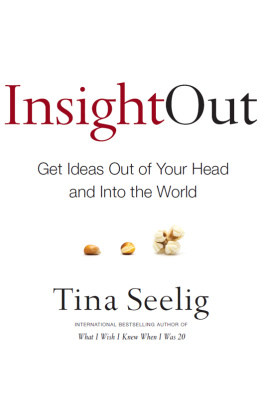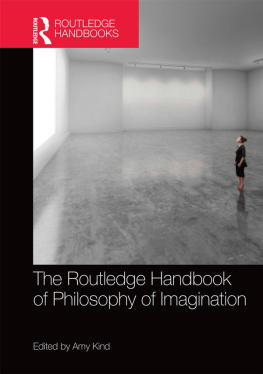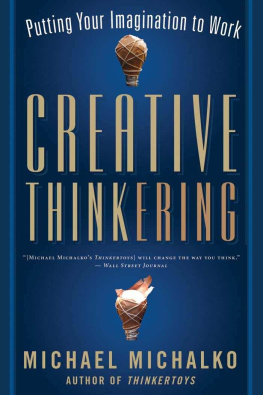THE LIFE OF IMAGINATION
THE
LIFE OF
IMAGINATION
Revealing
and Making
the World
Jennifer Anna Gosetti-Ferencei
Columbia University Press
New York

Columbia University Press
Publishers Since 1893
New YorkChichester, West Sussex
cup.columbia.edu
Copyright 2018 Columbia University Press
All rights reserved
E-ISBN 978-0-231-54816-8
Library of Congress Cataloging-in-Publication Data
Names: Gosetti-Ferencei, Jennifer Anna, author.
Title: The life of imagination : revealing and making the world / Jennifer Gosetti-Ferencei.
Description: New York : Columbia University Press, [2018] | Includes bibliographical references and index.
Identifiers: LCCN 2018010144 | ISBN 9780231189088 (cloth : alk. paper)
Subjects: LCSH: Imagination.
Classification: LCC BF408 .G636 2018 | DDC 153.3dc23
LC record available at https://lccn.loc.gov/2018010144
A Columbia University Press E-book.
CUP would be pleased to hear about your reading experience with this e-book at .
Cover design: Lisa Hamm
Cover image: copyright plainpicture/neuebildanstalt/Bilderbergwerk
FOR ALDEN
CONTENTS
R esearch and writing for this project was undertaken at the Research Centre at St. Johns College, Oxford, and continued during an affiliation with the Balzan Foundation Project, Literature as an Object of Knowledge, also based at St. Johns College, Oxford. Fordham University in New York City provided faculty fellowship leave, and the University of Birmingham in the UK research leave, both of which aided the realization of this book. Reviewers provided helpful commentary on the manuscript. I am incalculably indebted to my family and to others too numerous to name for inspiration and insight on the topics considered here.
I magination arises in and through conscious life and aims toward material and symbolic expression. Imagination does not only operate in the isolated mind, as one fantasizes, eyes shut closed to the world, or in the rare ecstatic moment only. Imagination allows us to take up the stuff of the world and of the mind and transform it, and as such it is essential to human flourishing. Yet imagination, perhaps more so than any other mode of consciousness, seems to elude our grasp. For despite over two millennia of thought on the subject of imagination, we have yet to fully understand the breadth of its activity, the depth of its roots in our cognition, and the scope of its influence in shaping human life and experience. The aim of this book is to offer a new understanding of imagination that accounts for the ways imagination invests our experience with possibilities for thinking and for acting, feeling, and being.
Imagination is involved in many kinds of human endeavor, and accordingly this book is aimed at a wide readership and draws from many fields of inquiry. The approach here diverges from the tendency, typical of much of the philosophical tradition, to treat imagination as one species of cognition segregated from others and as separate from creativity in general. Philosophers have often shed light on imagination by focusing on one specific capacityfor instance, inner representations, fantasizing, hypothesizing, or pretense. The ambition here is more encompassing and perhaps also more audacious: to understand the place of imagination in our cognitive ecology, its role in ordinary cognition as well as its exquisite and distinctive manifestations in some of the most special of human experiences. The focus here on the human imagination is not meant to deny the role of imagination in nonhuman animal life, recognized by philosophers since at least Aristotle. The main focus of this book is imagination as a transformative power, which both helps human beings to reveal the world, or to come to understand it in light of possibilities, and to make world, or to shape the reality before us by regarding it and changing it in new ways, integrating possibilities with what is given. That human beings need imagination to cope with the challenges we facemany of which are due to the activities of our own species alonealso motivates this effort to grasp its depth, breadth, and relevance in human life.
The imagination is not a single mental phenomenon or skill, but multifactorial, a constellation of related activities contributing constitutively to the full dimensionality of human consciousness and our relations to the world. This book shares an approach with those studies that, against the grain of a long tradition, suggest that imagination pervades many aspects of thought and action. Examining some of the modes of imaginative activity here, we will trace exceptional moments of imaginative intensitysuch as occur in art, literature, scientific discovery, and inventionto their roots in everyday human thought and practice.
Of course, imagination may often be associated with the unharnessed and lively wandering of childrens play, with eureka moments of discovery, or with artistic creativityexperiences distinct from the humdrum and the ordinary that may not seem to have much to do with everyday pragmatic life. Distinctly imaginative experiences differ from mundane thinking in that usual expectations and habits are ruptured by something unpredictable, by some inner impulse of spontaneity. Yet just as ordinary, quotidian life may harbor possibilities for extraordinary, even ecstatic experience, I suggest that such spontaneity is latent within the common flow of human consciousness. Far from being merely a private theater for ineffectual and incommunicable fantasizing, imagining may be prompted by our surrounding influences and inspirations, by communication with others, by worldly and cultural provocation, as well as by the existential momentum that arises in human self-reflection.
When trying to grasp imagination as both pervasive across thinking and capable of special exertions, some apparent paradoxes arise. For its workings are both natural to ordinary consciousness and, in its most heightened expression as in complex creative activity, depart from the ordinary, sometimes exceptionally so. Imagination draws from fundamental cognitive capacities but also breaks with our cognitive habits, our routine ways of thinking about the world or aspects of it. Creativitywhich I regard as an imaginative mode that draws upon several of its facilitiesis both situated in our relations to surrounding circumstances and enables their transcendence. Further augmenting the complexity of imagination, imagination has what has been called a reproductive facilitybased on and presenting images and ideas from previous experiencesas well as a productive facilitywhich is meant here that, though drawing from prior experience, imagination generates something new.
This emphasis on the productive imagination, its generativity, sets this study apart from the many accounts that define it primarily in terms of its capacity for reproducing or recreating ideasmaking resemblances, copies, or simulations of other experiences and merely recombining themin short, as a second-order operation of consciousness. The depiction of imagination as essentially reproductive reigned in philosophy almost uninterrupted from Plato to the mid-eighteenth century and remains characteristic of many contemporary views of the mind. Immanuel Kant, Samuel Taylor Coleridge, the Romantic writers, and Friedrich Nietzsche offered alternatives, yet the impact of their exploration of productive and creative imagining has been largely confined to the fields of aesthetics and literary theory or to the literature of the imaginary, a notion often evasive of clear definition and for the last century most readily associated with the cultural appropriations of psychoanalysis. The reproductive view still holds sway, even where the combinatory power of imagination is emphasized. Of course, a great deal of what the imagination does can be considered in reproductive terms. Aristotle classified imagination as a form of memory, and David Hume iterated that, despite its apparent freedomand its crucial role in connecting our otherwise unconnected ideasits power lies in combining impressions from previous experience. Insofar as new ideas seem to occur to us, imagination retrieves and mixes impressions of states and objects we have experienced before, leading to the commonplace idea that imagination, or creativity, is nothing more than putting old ideas together in new ways. Imagination can indeed be conceived in terms of the having of states that are not beliefs, desires or perceptions, but are like them in various ways, and those states can be thought as recreations by the mind. But since in so doing we can also project ourselves into another situation and to see, or think about, the world from another perspective, a further dimension of this taskthe shifting perspective, projecting possibility in excess of actuality, taking up a point of view on an alternativeis not exhausted by reproduction or resemblance, but involves excess and transformation. This surplus of imaginative play beyond reproduction and combination merits serious consideration, for it is in transcending the actual that imagination, as Jean-Paul Sartre aimed to show, is essential to human freedom.
Next page

